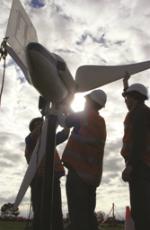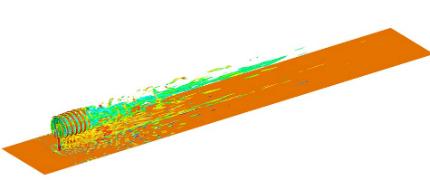Wind, Wave & Tidal Power
Research at the CET is focused on optimising the components in wind and wave turbines relating to noise and vibration, efficiency and aerodynamic optimisation.
-
Researchers
-
Wind power

Wind power is the conversion of wind energy into a useful form of energy, such as electricity, using wind turbines. Wind energy as a power source is becoming increasingly attractive as an alternative to fossil fuels, because it is plentiful, renewable, widely distributed and produces no greenhouse gas emissions, although it is an intermittent source of energy and can have other disadvantages such as noise. As well as the research projects below, CET researchers have also developed new technologies that contribute to producing efficient wind power, which also reduce noise.
Wind farm design software
Associate Professor Nesimi Ertugrul is leading a team of researchers that are working to optimise wind power generation. The team are investigating many aspects of wind power, from control strategies in AC/DC converters in small scale wind farms to the efficient design of large scale on-shore wind farms.
As part of their research the team has developed a genetic algorithm-based optimisation method for wind farm design. The software employs computing power and mathematical algorithms to test hundreds or even thousands of potential cable network options for standard on-shore wind farm layouts. Through this software users can employ mathematics to optimise design rather than a time-consuming iterative manual calculation process. Users can select from a range of design components, including underground, overhead, single or triple-core cables as well as allow for inaccessible areas of a site (e.g. rivers, or locations with ownership or access issues). Decisions can also be made to maximise reliability or minimise costs. Industry is already saving significant time and money through increased efficiency of wind farm design assessment using this software.
Using turbine wakes to inform wind farm design
The majority of Australia’s 52 wind farms are clusters of Horizontal Axis Wind Turbines with rotor diameters of approximately 100 metres. Clustering makes practical and economic sense but it means that most turbines operate in the wake of other turbines which impacts on power output, dynamic loads, fatigue life due to turbulence and potentially noise levels.

Wind turbine wake
Associate Professor Maziar Arjomandi, Professor Ben Cazzolato, Dr Mergen Ghayesh, Associate Professor Richard Kelso and their team are researching the impact of wake interactions using high-performance computers. They are simulating a high fidelity numerical model of the wake characteristics of a single turbine and computing the dynamics of the near-wake and far-wake. Their results show that wake turbulence intensity can reach 10 per cent for a turbine operating in a low-turbulence wind (12 metres/second). This generates excessive dynamic loading on the blade and reduces performance. The interaction between the blade and vortex structures generated in the far-wake can be responsible for the low frequency ‘thumping’ noise sometimes reported near wind farms.
The team are now using the Adelaide large scale wind tunnel and the University of Adelaide High Performance Computer to investigate wake propagation by multiple turbines. Research results will help wind farm developers improve wind farm layout to reduce the impact of turbines on each other and maximise efficiency, potentially by staggering turbines or deflecting wakes.
Link to research into Heliostat Wind Loads.
-
Wave and tidal power
-
Clients and collaborators
